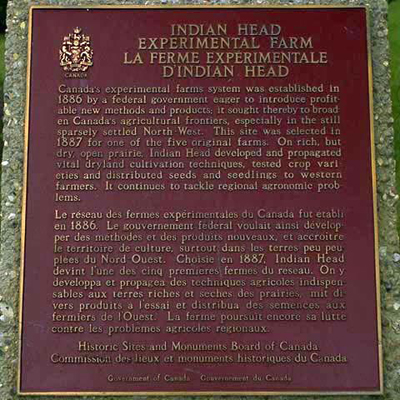Establishment of the Experimental Farm Branch National Historic Event
Multiple plaque locations

HSMBC plaque
© Parks Canada / Parcs Canada, 1989
Address :
Multiple plaque locations
Recognition Statute:
Historic Sites and Monuments Act (R.S.C., 1985, c. H-4)
Designation Date:
1981-11-13
Other Name(s):
-
Establishment of the Experimental Farm Branch
(Designation Name)
Importance:
5 experimental farms established by the federal government, 1886
Plaque(s)
Existing plaque: Brandon Research Station Valley Road at 18th Street, Brandon, Manitoba
Canada's experimental farms system was established in 1886 by a federal government eager to introduce profitable new methods and products; it sought thereby to broaden Canada's agricultural frontiers, especially in the still sparsely settled North-West. The Brandon Experimental Farm, one of the original five, was acquired in 1888. Since then it has tested and introduced crops, livestock and cultivation techniques adapted to the eastern prairies. The farm has become a research station, conducting widely applicable studies in plant and animal science.
Existing plaque: Pacific Agricultural Research Centre 6947 Highway 7, Agassiz, British Columbia
Canada's experimental farms system was established in 1886 by a federal government eager to introduce profitable new methods and products; it sought thereby to broaden Canada's agricultural frontiers, especially in the still sparsely settled North-West. The Agassiz Experimental Farm, one of the original five, was acquired in 1888. Initially it emphasized livestock and the evaluation of new crops for the area, particularly fruit and trees. The farm has become a modern research station which has aided in making south coastal British Columbia the most intensive agricultural area in Canada.
Existing plaque: 1 Angus Street east, Indian Head, Saskatchewan
Canada's experimental farms system was established in 1886 by a federal government eager to introduce profitable new methods and products; it sought thereby to broaden Canada's agricultural frontiers, especially in the still sparsely settled North-West. This site was selected in 1887 for one of the five original farms. On rich, but dry, open prairie, Indian Head deve1oped and propagated vital dryland cultivation techniques, tested crop varieties and distributed seeds and seedlings to western farmers. It continues to tackle regional agronomic problems.
Existing plaque: on a polished slab of rock at entrance Highway 302, Nappan, Nova Scotia
Canada' s experimental farms system was established in 1886 by a federal government eager to introduce profitable new methods and products; it sought thereby to broaden Canada's agricultural frontiers. Of the five original farms, this one, comprising upland and marsh soils, was selected in 1887 to serve the Maritimes. In seeking solutions to the area' s crop and livestock problems, the Nappan Experimental Farm continues to conduct research on methods of improving livestock management systems and crop production on both upland and dykeland soils.
Existing plaque: Driveway just west of traffic circle at Birch Drive, Ottawa, Ontario
Canada's experimental farm system was begun in 1886 by a federal government eager to introduce profitable new methods and products; it sought thereby to broaden Canada's agricultural frontiers, especially in the still sparsely settled North West. Acquired in 1886, this Central Experimental Farm was the first of the original five. As the research headquarters of a vast network of experimental stations, it continues to specialize in food and agricultural research projects. In the heart of the city, it exhibits the progress in plant, livestock and agricultural technology.